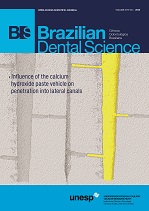The relationship between ras protein and odontogenic lesions
DOI:
https://doi.org/10.14295/bds.2018.v21i3.1572Abstract
Odontogenic lesions comprise a diverse group of lesions which usually affect the oral cavity and are derived from embryonic dental tissues. Their mechanisms of development and progression are still not fully known, but there are some studies investigating the participation of specific proteins in these events. Objective: The objective of this study was to investigate the expression of KRAS protein in these pathologies and also to correlate the protein expression with the behaviour of the lesions studied. Material and Methods: Immunohistochemical analysis of 20 cases was performed for each one of the following lesions: dentigerous cyst (DC), odontogenic keratocyst (OKC) and ameloblastoma (AB), totalising 60 cases to be analysed. Results: By considering the KRAS immune-expression, there were 11 cases (55%) presenting over-expression (score 3) in the basal layer of DC and 13 cases (65%) in the supra-basal layer. A similar finding was observed in the analysis of OKC, with eight cases (40%) in the supra-basal layer (score 3) and only five cases (25%) in the basal layer. As for AB, the over-expression was found in six cases (30%). Conclusion: Therefore, one believes that the KRAS expression in odontogenic lesions is inversely proportional to their aggressive behaviour.
Keywords
KRAS; Odontogenic lesions; Immunohistochemistry
Downloads
Downloads
Published
How to Cite
Issue
Section
License
Brazilian Dental Science uses the Creative Commons (CC-BY 4.0) license, thus preserving the integrity of articles in an open access environment. The journal allows the author to retain publishing rights without restrictions.
=================




























